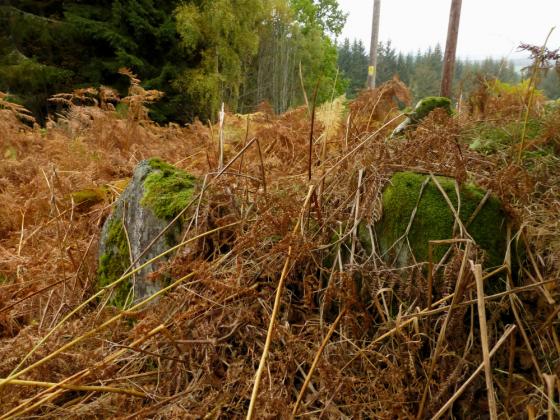Canmore description, including finds:
At Stoneyfield are the remains of a Clava-type cairn. All that remains is the major part of an impressive cairn kerb, 58’ indiameter. The cairn itself and the internal structure have been removed, though when seen by Anderson (J Anderson 1831) in about 1824 the cairn seems to have been fairly complete. The stones forming the kerb are massive boulders, the largest being on the SW arc – the tallest, a leaning stone at the S end of this arc, 4’9” high – and other stones are 4’6” to 4’3” high. The stones in the NE arc are 1’9” to 2’9” high. Many stones have fallen inwards or outwards but have not been disturbed, and several have been reduced by blasting. There is no sign, nor it there any record, of monoliths which may once have surrounded the cairn.
In 1760 two stone circles were recorded at Stoneyfield. (a, b) (This feature was first published on OS 6"map as “Stone Circle”).
A S Henshall 1963; R Pococke 1887; New Statistical Account (NSA, A Rose, A Clark and R Macpherson) 1845, G Anderson 1831; J Fraser 1884; Visited by OS (W D J) 30 March 1960.
Later finds from this cairn, excavated in 1972 and 1973, included a 2nd century Roman brooch and a sherd of coarse ware.
D D A Simpson 1973, 1974.
The excavation of this cairn in 1972-3 revealed that beneath it there had been a rectangular timber building, 9.5m long with a central stone hearth, probably associated with a series of pits containing Grooved Ware. The cairn itself consisted of a heavy stone kerb with traces of
an external stone platform on the W; in the central area there was a series of pits and cists, some of them contemporary with the cairn, some later. Several of the pits contained cremations, and in one of the cists there was a Food Vessel. A Cordoned Urn with a cremation had also been deposited in the cairn. Other articles found included a cup-marked stone, a 2nd century Roman brooch, and a sherd of coarse ware.
A S Henshall 1963; D D A Simpson 1973, 1974; RCAHMS 1979.
The kerb of this cairn was re-erected at NH 6878 4508 in advance of a new road, which now occupies the original site.
Resurveyed at 1:1250.
Visited by OS 26 January 1979.





















































































































































